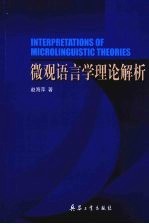
- 作 者:赵海萍著
- 出 版 社:北京:兵器工业出版社
- 出版年份:2009
- ISBN:9787802483446
- 标注页数:206 页
- PDF页数:218 页
请阅读订购服务说明与试读!
订购服务说明
1、本站所有的书默认都是PDF格式,该格式图书只能阅读和打印,不能再次编辑。
2、除分上下册或者多册的情况下,一般PDF页数一定要大于标注页数才建议下单购买。【本资源218 ≥206页】
图书下载及付费说明
1、所有的电子图书为PDF格式,支持电脑、手机、平板等各类电子设备阅读;可以任意拷贝文件到不同的阅读设备里进行阅读。
2、电子图书在提交订单后一般半小时内处理完成,最晚48小时内处理完成。(非工作日购买会延迟)
3、所有的电子图书都是原书直接扫描方式制作而成。
Chapter 1 From Language to Linguistics 1
1.1 Definition of language 1
1.2 Origin of language 3
1.2.1 The divine origin theory 4
1.2.2 The inner spirit theory 5
1.2.3 The nature theory 6
1.2.4 The Sing-song theory 7
1.3 The natures of language 7
1.3.1 Displacement 8
1.3.2 Arbitrariness 8
1.3.3 Duality 9
1.3.4 Productivity or creativity 10
1.3.5 Cultural transmission 11
1.3.6 Structure-dependence 12
1.4 Functions of language 13
1.4.1 Informative or ideational function 13
1.4.2 Interpersonal function 14
1.4.3 Performative function 15
1.4.4 Emotive function 15
1.4.5 Phatic communication 16
1.4.6 Evocative function 17
1.4.7 Recreational function 17
1.4.8 Metalingual function 17
1.5 From language to linguistics 18
1.5.1 Linguistic knowledge 19
1.5.2 Modern linguistics and traditional grammar 19
1.5.3 The scope of linguistics 20
1.6 Important distinctions in microlinguistics 25
1.6.1 Synchronic vs.diachronic studies 25
1.6.2 Speech vs.writing 26
1.6.3 Descriptive approach vs.prescriptive approaches 27
1.6.4 Langue vs.parole 28
1.6.5 Competence vs.performance 29
1.6.6 Macrolinguistics vs.microlinguistics 29
1.7 Summary 30
Exercises 31
Chapter 2 From Phonetics to Phonology2.1 Phonetics 38
2.1.1 Articulatory phonetics 38
2.1.2 Acoustic phonetics 39
2.1.3 Auditory phonetics 40
2.2 Speech organs 40
2.2.1 The initiator of the air stream 41
2.2.2 Vocal cords 41
2.2.3 Resonating cavities 41
2.3 Segments and phonetic transcription 47
2.3.1 Segments 47
2.3.2 IPA and phonetic transcription 47
2.4 Consonants 50
2.4.1 Consonants and vowels 50
2.4.2 Manners of articulation 51
2.4.3 Places of articulation 52
2.4.4 The consonants of English 52
2.5 Vowels 54
2.5.1 The criteria of vowel description 54
2.5.2 The theory of cardinal vowels 55
2.6 Coarticulation and phonetic transcription 56
2.7 Broad and narrow transcriptions 57
2.8 From phonetics to phonology 58
2.9 Phonemes and allophones 58
2.9.1 The phoneme theory 58
2.9.2 Allophones 60
2.10 Phonological processes 62
2.10.1 Sequential rules 62
2.10.2 Assimilation 63
2.10.3 Deletion rule 65
2.10.4 Devoicing 65
2.11 Distinctive features 66
2.12 Suprasegmental features 67
2.12.1 Syllables 67
2.12.2 Stress 67
2.12.3 Intonation 69
2.12.4 Tone 70
2.13 Summary 70
Exercises 71
Chapter 3 Morphology:the Words of Language3.1 Introduction 79
3.2 Content words and functional words 80
3.3 Morpheme:the minimal units of meaning 80
3.3.1 The individual morpheme 81
3.3.2 Rules that combine morphemes 84
3.4 Summary 87
Exercises 90
Chapter 4 Syntax:Sentence Structures 90
4.1 The traditional approach 101
4.1.1 Number,gender and case 101
4.1.2 Tense,aspect and voice 102
4.1.3 Concord and government 103
4.1.4 Types of sentence 104
4.2 The structural approach 105
4.2.1 Signifier and signified 108
4.2.2 Syntagmatic and paradigmatic relations 109
4.2.3 Immediate constituent analysis(IC analysis) 110
4.2.4 Endocentric and exocentric constructions 111
4.3 The generative approach 112
4.3.1 Deep and surface structures 113
4.3.2 The trace theory 114
4.3.3 Government,binding,etc 115
4.4 The functional approach 116
4.4.1 Functional sentence perspective 118
4.4.2 Systemic-functional grammar 119
4.5 Summary 123
Exercises 123
Chapter 5 Semantics:the Meaning of Language5.1 Introductions to semantics 130
5.2 Some views concerning the study of meaning 131
5.2.1 The Naming Theory 131
5.2.2 Conceptualism(Mentalism) 132
5.2.3 Contextualism 133
5.2.4 Behaviorism 134
5.3 Lexical semantics 135
5.3.1 Reference and sense 135
5.3.2 Utterance,sentence,proposition and propositional content 136
5.3.3 Some well-known word relations 137
5.4 Sense relations between sentences 142
5.4.1 X is synonymous with Y 143
5.4.2 X is inconsistent with Y 143
5.4.3 X entails Y 143
5.4.4 X presupposes Y.(Y is prerequisite of X) 144
5.4.5 X is a contradiction 144
5.5 Analysis of meaning 144
5.5.1 Componential analysis—a way to analyze lexical meaning 144
5.5.2 Predication analysis—a way to analyze sentence meaning 145
5.6 Summary 149
Exercises 150
Chapter 6 Pragmatics:the Language in Use6.1 Introductions 157
6.2 Context and meaning:deixis as an example 159
6.2.1 Spatial deixis 161
6.2.2 Temporal deixis 162
6.2.3 Discourse deixis 162
6.2.4 Person deixis 162
6.2.5 Social deixis 162
6.3 Speech Acts 163
6.3.1 Austin's model of Speech Acts 163
6.3.2 Searle's classification of Speech Acts 165
6.4 The Cooperative Principle 168
6.5 Implicature 170
6.6 Other interests of pragmatics 171
6.7 Summary 173
Exercises 175
Index:A glossary of some linguistic terms 180
References 204
